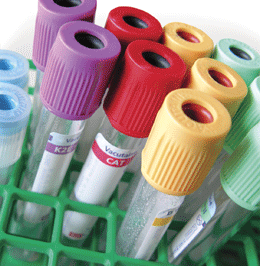
If you’re reading this, odds are your umbilical cord—the tube-like duct that nourished you in utero—was discarded as medical waste when you were born.
Until the mid- to late-1990s, the cords were routinely thrown away, obsolete once a newborn took its first breath. Today, though, breakthroughs in biotechnology have placed significant value on umbilical cords—and, more specifically, on the stem cell-bearing blood within them. Those cells, even more so than stem cells found in bone marrow, can readily morph into the cells that compose various body tissues—but without the pain and difficulty involved with bone marrow extraction.
Consequently, banked cord blood is being used with increased frequency to treat life-threatening illnesses ranging from leukemia to immune disorders to cerebral palsy. Now, sixth legislative district Assemblyman Louis Greenwald is looking to make cord blood banking available to all New Jersey residents, via a $5 million bill currently wending its way through the Assembly’s Health and Senior Services Committee.
“The banking of umbilical cord blood is a life-saving measure, and a policy that makes it available to all people has the potential to provide invaluable joy and relief to New Jersey families,” Greenwald says.
His proposal, if passed, would establish a statewide cord blood bank and require that health insurers cover the costs of collecting, processing and transporting cord blood. While private cord blood banking has grown increasingly popular among affluent parents in recent years, Greenwald’s proposal would make it accessible to everyone, allowing cord blood donors to choose between reserving their cord blood for their own future use, or donating it for the common good.
“Thirteen years ago, when my daughter was born, we privately banked her blood,” Greenwald ex?plains. “At the time, it cost $1,500, and then $100 per year for storage. We knew we were fortunate to have the means to do this, and I immediately thought, ‘This should be available to everyone.’”
Why not? After all, one of the pioneers in stem cell biobanking, the Coriell Institute for Medical Research, is located here in South Jersey. The Camden-based institute has provided biomaterials to researchers in 63 countries. Among the potential uses, says Coriell’s Courtney Kronenthal, are medical treatments and pre-clinical drug trials. “Imagine testing an Alzheimer’s medication on a Petri dish of neurons, before beginning a clinical trial,” she says. “The idea is that many medications can be screened using these powerful stem cells and could move forward to clinical trials. This can save the health care system a lot of money.”
But for soon-to-be moms and dads already busy painting nurseries, choosing caregivers and selecting names, the decision of whether to bank cord blood isn’t always a focus. “I meet a lot of expectant parents today who are just overwhelmed by it all,” says Andrea Racobaldo, coordinator of prenatal education at Lourdes Health System.
Currently, New Jersey parents can do one of three things with a newborn’s umbilical cord blood: Trash it, privately bank it for personal use or donate it to a registered blood bank. The latter is appealing to those who can’t afford private collection, (which, today, generally costs between $1,500 and $2,500 at birth, and approximately $150 annually for storage), but who don’t want the blood to go to waste.
By aiming to grow the statewide bank, Greenwald hopes that access to life-saving cells can be a reality for all. “The larger the bank, the greater the opportunity that someone you know and love can be saved,” he says. “And donating to that bank is an opportunity to do something special.” In addition, the bill would require insurers of group plans representing more than 50 people to cover collection and initial storage costs for those banking blood for personal use.
New Jersey residents already have unique, albeit limited, access to public cord blood collection: the New Jersey Cord Blood Bank is one of only 12 public banks in the nation that distributes donated stem cells to recipients nationwide. The service comes at no cost to parents, but is available in South Jersey only to families delivering at one of two partner hospitals: Our Lady of Lourdes Medical Center and Cooper University Hospital Medical Center, both in Camden.
“The New Jersey Cord Blood Bank is a nonprofit, and, without additional funding to support the program, we just cannot afford to expand and collect in all hospitals,” says Karen Ferriday, director of community affairs for Community Blood Services, parent organization to the New Jersey Cord Blood Bank. In fact, the number of collection sites has actually declined from 25 hospitals to five statewide, partly due to the fact that $150 million in planned state funding for the blood bank was canceled thanks to budget shortfalls.
“Camden is a collection hub for umbilical cord blood donated in the lower half of the state; we rent space off the Coriell Institute for this purpose,” explains Misty Marchioni, director of operations and business development for the stem cell division of Community Blood Services. Blood is then transported to a processing center in Allendale (Bergen County).
If Greenwald’s proposed bill passes, banking could become available at all hospitals statewide.
For now, parents delivering at non-participant hospitals can still donate by visiting the website Marrow.org and inquiring about a kit that allows doctors at any hospital to collect blood for donation. The New Jersey Cord Blood Bank also encourages prospective donors to contact their local legislators about bringing the option to more hospitals in South Jersey.
“Whether families privately bank the blood or donate it is a personal choice,” notes Marchioni. “Every family is different, and some might have a personal history of cancer or leukemia that prompts them to bank it for themselves. Our goal is simply to make sure people understand all the options, and to encourage them to do more than just throw the cord blood out.”
Karyn Lockshine of Hainesport gave birth to her son, Robert Jason, at Cooper University Hospital. She was drawn to the idea of storing her son’s umbilical cord blood in case of a medical emergency down the road, but was deterred by the hefty price.
“We decided instead to donate the blood to the bank in case someone else needed it,” Lockshine explains. “I felt good knowing it could help someone else, and I also like knowing there’s an umbilical cord blood bank nearby in case, God forbid, my son ever needed blood from it.”
Currently, parents cannot regain access to their own baby’s cord blood once it’s been donated. “When parents donate their baby’s cord blood, they give up rights to it, and it is de-identified before being placed on the registry,” Marchioni explains. “However, if a child develops a disease that needs to be treated with stem cells, their own cells might not have necessarily been the best match. Community Blood Services will do its best to assist any of our donors searching for an acceptable stem cell transplant. If parents are worried about getting their own cells, should they need them, they should seriously consider a private banking option.”
Chrissy Poulton of Lindenwold weighed her options and ultimately decided to do just that.
“My husband and I thought of it as a baby insurance policy,” she says of her son Chase’s cord blood, which is banked privately. “Like any insurance policy, you hope you never need to use it—but I didn’t want to ever regret throwing the cord blood away and then needing it.”
She researched a number of banking providers before choosing M.A.Z.E. Cord Blood Laboratories.
“Uses for stem cells are limited now, but in the future, you never know what the cells’ capabilities might include,” Poulton insists. “I think banking cord blood will be a no-brainer 50 years from now.”
Published (and copyrighted) in South Jersey Magazine, Volume 7, Issue 12 (March, 2011).
For more info on South Jersey Magazine, click here.
To subscribe to South Jersey Magazine, click here.
To advertise in South Jersey Magazine, click here.












